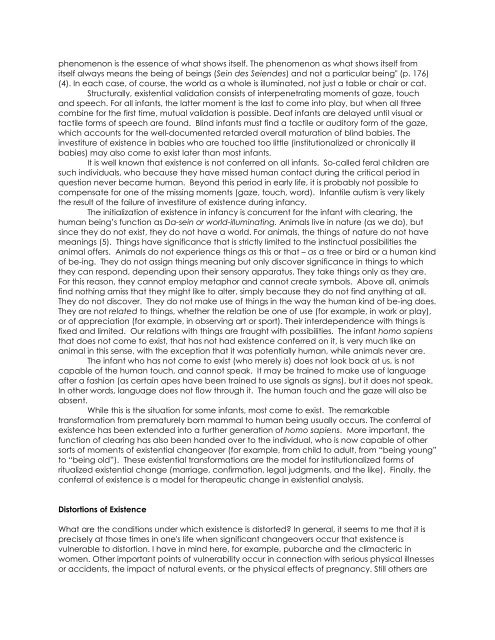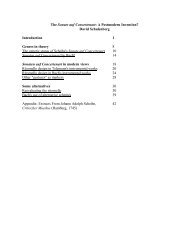SEVEN PAPERS ON EXISTENTIAL ANALYSIS ... - Wagner College
SEVEN PAPERS ON EXISTENTIAL ANALYSIS ... - Wagner College
SEVEN PAPERS ON EXISTENTIAL ANALYSIS ... - Wagner College
You also want an ePaper? Increase the reach of your titles
YUMPU automatically turns print PDFs into web optimized ePapers that Google loves.
phenomenon is the essence of what shows itself. The phenomenon as what shows itself from<br />
itself always means the being of beings (Sein des Seiendes) and not a particular being" (p. 176)<br />
(4). In each case, of course, the world as a whole is illuminated, not just a table or chair or cat.<br />
Structurally, existential validation consists of interpenetrating moments of gaze, touch<br />
and speech. For all infants, the latter moment is the last to come into play, but when all three<br />
combine for the first time, mutual validation is possible. Deaf infants are delayed until visual or<br />
tactile forms of speech are found. Blind infants must find a tactile or auditory form of the gaze,<br />
which accounts for the well-documented retarded overall maturation of blind babies. The<br />
investiture of existence in babies who are touched too little (institutionalized or chronically ill<br />
babies) may also come to exist later than most infants.<br />
It is well known that existence is not conferred on all infants. So-called feral children are<br />
such individuals, who because they have missed human contact during the critical period in<br />
question never became human. Beyond this period in early life, it is probably not possible to<br />
compensate for one of the missing moments (gaze, touch, word). Infantile autism is very likely<br />
the result of the failure of investiture of existence during infancy.<br />
The initialization of existence in infancy is concurrent for the infant with clearing, the<br />
human being’s function as Da-sein or world-illuminating. Animals live in nature (as we do), but<br />
since they do not exist, they do not have a world. For animals, the things of nature do not have<br />
meanings (5). Things have significance that is strictly limited to the instinctual possibilities the<br />
animal offers. Animals do not experience things as this or that – as a tree or bird or a human kind<br />
of be-ing. They do not assign things meaning but only discover significance in things to which<br />
they can respond, depending upon their sensory apparatus. They take things only as they are.<br />
For this reason, they cannot employ metaphor and cannot create symbols. Above all, animals<br />
find nothing amiss that they might like to alter, simply because they do not find anything at all.<br />
They do not discover. They do not make use of things in the way the human kind of be-ing does.<br />
They are not related to things, whether the relation be one of use (for example, in work or play),<br />
or of appreciation (for example, in observing art or sport). Their interdependence with things is<br />
fixed and limited. Our relations with things are fraught with possibilities. The infant homo sapiens<br />
that does not come to exist, that has not had existence conferred on it, is very much like an<br />
animal in this sense, with the exception that it was potentially human, while animals never are.<br />
The infant who has not come to exist (who merely is) does not look back at us, is not<br />
capable of the human touch, and cannot speak. It may be trained to make use of language<br />
after a fashion (as certain apes have been trained to use signals as signs), but it does not speak.<br />
In other words, language does not flow through it. The human touch and the gaze will also be<br />
absent.<br />
While this is the situation for some infants, most come to exist. The remarkable<br />
transformation from prematurely born mammal to human being usually occurs. The conferral of<br />
existence has been extended into a further generation of homo sapiens. More important, the<br />
function of clearing has also been handed over to the individual, who is now capable of other<br />
sorts of moments of existential changeover (for example, from child to adult, from “being young”<br />
to “being old”). These existential transformations are the model for institutionalized forms of<br />
ritualized existential change (marriage, confirmation, legal judgments, and the like). Finally, the<br />
conferral of existence is a model for therapeutic change in existential analysis.<br />
Distortions of Existence<br />
What are the conditions under which existence is distorted? In general, it seems to me that it is<br />
precisely at those times in one's life when significant changeovers occur that existence is<br />
vulnerable to distortion. I have in mind here, for example, pubarche and the climacteric in<br />
women. Other important points of vulnerability occur in connection with serious physical illnesses<br />
or accidents, the impact of natural events, or the physical effects of pregnancy. Still others are















